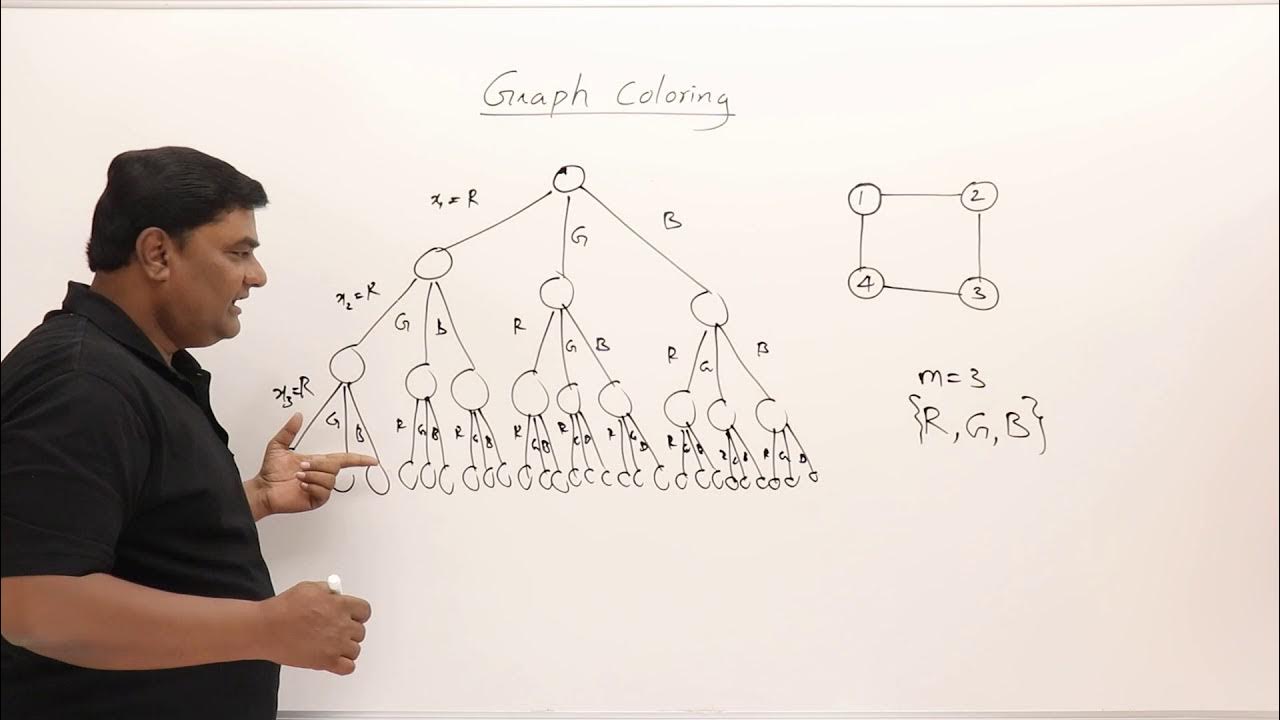Pewarnaan Graf (Graph Coloring) PART 2 | Algoritma Welch Powell & Contoh kasus penyimpanan zat kimia
Summary
TLDRThis video explains the concept of graph coloring, applied to the storage of seven chemicals in a warehouse. Each chemical has constraints on which others it can be stored with, based on safety requirements. The process involves representing the problem as a graph, where chemicals are nodes, and edges indicate incompatible pairings. The graph is then colored, ensuring that no two adjacent nodes share the same color, representing separate storage rooms. Through this method, the video demonstrates how to minimize the number of storage rooms required, ultimately needing only three rooms for all the chemicals.
Takeaways
- 😀 The video explains the application of graph theory in solving a chemical storage problem.
- 😀 Seven different chemicals (A, B, C, D, E, F, G) need to be stored in separate rooms to avoid dangerous reactions.
- 😀 Some chemicals cannot be stored together, and this incompatibility is represented by a graph where nodes are chemicals and edges represent incompatibility.
- 😀 The graph coloring algorithm is used to find the minimum number of storage rooms required.
- 😀 Each room corresponds to a different color in the graph, and adjacent nodes (chemicals) cannot share the same color.
- 😀 The solution involves finding the least number of colors required to color the graph, which corresponds to the minimum number of rooms needed.
- 😀 The process starts by coloring the node with the highest degree (most edges).
- 😀 After coloring a node, the next step is to color adjacent nodes with different colors until all nodes are assigned a color.
- 😀 The final result shows that 3 storage rooms are sufficient to store all seven chemicals safely.
- 😀 The three storage rooms are allocated as follows: Room 1 for chemicals B and C, Room 2 for chemicals D and G, and Room 3 for chemicals A, E, and F.
Q & A
What is the main topic of the script?
-The main topic of the script is about applying graph theory to solve the problem of determining the minimum number of storage rooms required for storing seven types of chemicals, considering their incompatibilities.
Why can't certain chemicals be stored in the same room?
-Certain chemicals cannot be stored in the same room because their gas mixtures are prone to exploding when combined. Hence, they must be stored separately.
How does graph theory help solve the problem of storing chemicals?
-Graph theory is used by treating each chemical as a node (vertex) in a graph, and incompatibilities between chemicals as edges connecting those nodes. The problem then reduces to finding the minimum number of colors (representing storage rooms) needed to color the graph such that no two adjacent nodes (incompatible chemicals) share the same color.
What is the significance of the 'coloring' concept in graph theory?
-In graph theory, coloring refers to assigning colors to nodes in such a way that no two adjacent nodes share the same color. In this case, the colors represent different storage rooms, and adjacent nodes indicate chemicals that cannot be stored in the same room.
How is the table used to create the graph?
-The table lists the incompatibilities between chemicals. Each row represents a chemical and marks which chemicals it cannot be stored with using an 'X'. This information is used to create edges in the graph between incompatible chemicals.
What does the 'degree' of a node represent in the context of this problem?
-The 'degree' of a node represents the number of edges connected to it, which corresponds to the number of chemicals that a specific chemical is incompatible with. A higher degree indicates more incompatibilities.
Which chemical has the highest degree, and how does it affect the coloring process?
-Chemical B has the highest degree, with a degree of 5. This chemical is assigned the first color, and then the coloring process continues by ensuring that chemicals adjacent to it (incompatible with B) receive different colors.
How are chemicals with the highest degree selected during the coloring process?
-At each step, the chemical (node) with the highest degree among the uncolored nodes is chosen for coloring. This ensures that the most constrained chemicals are handled first, minimizing the chances of conflicts in the coloring process.
How many different storage rooms (colors) are needed to store all the chemicals?
-A total of three different storage rooms (colors) are needed, as three distinct colors are assigned during the graph coloring process: red, yellow, and green.
Can you provide an example of which chemicals go into which storage rooms?
-In the first storage room (red color), chemicals B and C can be stored. In the second storage room (yellow color), chemicals D and G can be stored. Finally, in the third storage room (green color), chemicals A, E, and F can be stored.
Outlines

This section is available to paid users only. Please upgrade to access this part.
Upgrade NowMindmap

This section is available to paid users only. Please upgrade to access this part.
Upgrade NowKeywords

This section is available to paid users only. Please upgrade to access this part.
Upgrade NowHighlights

This section is available to paid users only. Please upgrade to access this part.
Upgrade NowTranscripts

This section is available to paid users only. Please upgrade to access this part.
Upgrade NowBrowse More Related Video

6.3 Graph Coloring Problem - Backtracking

Pewarnaan Graf (Graph Coloring) PART 1 | Algoritma Welch Powell & Contoh kasus penjadwalan kuliah

Abordagem da Coloração em Grafos | Teoria dos Grafos | 2025.1

What to specify in a chemical warehouse design

Introduction to Graph Theory: A Computer Science Perspective

DIGITAL COLORING Like a PRO! - Fast and Effective!
5.0 / 5 (0 votes)